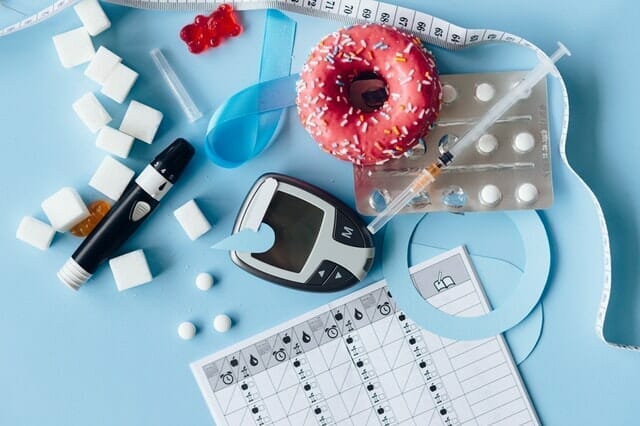Diabetes is an extremely insidious disease, which is initially difficult to notice and which affects more and more people, unfortunately even the very young. It is estimated that in Poland we have about 3 million people suffering from diabetes, and among them 1 million are not aware of this fact. Meanwhile, serious disease can be avoided if we timely diagnose the so-called pre-diabetic state and take appropriate steps.
Pre-diabetes, i.e. a metabolic disorder characterised by elevated blood glucose levels, is a serious risk signal for the development of diabetes, although fortunately it is reversible and requires only immediate lifestyle changes.
Table of contents
Pre-diabetes – symptoms. How to recognize pre-diabetes?
Abnormal glucose tolerance, or pre-diabetes, is characterized by higher blood sugar levels, although not as high as in the case of diabetes. Nevertheless, if not diagnosed on time or not treated, it can lead to the development of type 2 diabetes, which is unfortunately already irreversible.
Usually, initially there are not very large disturbances in carbohydrate metabolism, sometimes difficult to detect through tests. Over time, glucose levels rise only in the morning or after a meal. However, gradually, the body’s equilibrium is disturbed, and sugar levels begin to oscillate around or even exceed the upper limit.
This kind of even small, but constant increase in blood sugar levels has a very negative effect on the condition of blood vessels and peripheral nerves and threatens to transform the pre-diabetic state into advanced diabetes. Moreover, already at this stage serious changes in the organ of vision may occur.
The following symptoms should prompt us to take the appropriate steps, the first of which is to perform tests and possibly visit a doctor:
- permanently felt tiredness,
- excessive sleepiness, manifested for example by a sudden need to take a nap,
- unjustified increase in appetite and thirst,
- dry mouth,
- excessive dryness of the skin,
- frequent urination,
- frequent infections,
- sudden vision problems.
Sugar curve – norms
Pre-diabetes is the intermediate state between being healthy and having type 2 diabetes. Tests are by far the best tool to establish the facts and a starting point for appropriate action.
The normal fasting blood glucose level in a healthy person is between 70-99 mg/dl. If the test result is between 100 and 125 mg/dl, an additional OGTT test should be performed, the so-called sugar curve. The sugar curve involves taking a venous blood sample, then administering a glucose solution, and testing the sugar level again after 60 and 120 minutes.
A fasting blood sugar level on a sugar curve test between 100-125 mg/dl is an abnormal fasting blood glucose. A result between 140-200 mg/dl two hours after glucose ingestion is abnormal glucose tolerance.
These types of results indicate a pre-diabetic state, that is, the last moment before the development of full-blown diabetes. Whereas, a result of 200 mg/dl and above, indicates advanced type 2 diabetes.
Pre-diabetes – causes, risk factors

Although pre-diabetes is not yet diabetes, it can develop into it at any time. That’s why it shouldn’t be underestimated, and if our lifestyle is a source of risk factors, we should even more systematically test our blood glucose level.
The main causes of abnormal glucose tolerance, i.e. potentially dangerous circumstances for health, are primarily considered to be overweight and obesity, as well as poor diet and lack of physical activity.
These are followed by:
- cardiovascular diseases,
- hypertension,
- high cholesterol levels,
- polycystic ovarian syndrome,
- previous gestational diabetes,
- genetic conditions.
Analogous reasons are also mentioned in the context of diabetes itself.
What is the relationship between obesity and pre-diabetes or diabetes? Well, excess body fat contributes to the increased production of various substances that interfere with the proper functioning of insulin and glucose uptake by our body cells.
As a result, a subtle balance in the body is disturbed, which results in a whole range of negative metabolic phenomena and, consequently, may lead to such serious diseases as damage to the heart, blood vessels, kidneys, eyesight, and nervous system.
An equally important influence on the possible development of diabetes is the lifestyle. Lack of exercise and the so called sedentary lifestyle carries the risk of disorders of the whole organism, mainly of the cardiovascular system, but also of the respiratory, nervous, muscular, skeletal and joint systems.
Over time, the heart’s ability to pump blood diminishes, body cells are under-oxygenated and less well nourished, lung capacity decreases, bones, muscles and joints are weakened. Metabolism slows down, carbohydrate metabolism is disturbed, instead of producing energy, the body accumulates reserves in the form of fat tissue.
Pre-diabetes – tests, diagnosis
In order to eliminate the risk of developing diabetes, it is necessary to thoroughly change the lifestyle and diet. But this is not all. Since in the case of many diseases, including diabetes, the most important thing is early diagnosis, i.e. at the stage of pre-diabetes, it is worth carrying out a glucose level test from time to time.
Frequent screening tests are an excellent opportunity for this. Apart from checking the blood sugar level, a glucose load test, the so-called sugar curve, may be performed.
This type of test has full diagnostic value, provided that we follow certain rules; first of all, a few days before the test we should not radically change our lifestyle or diet, because the change will falsify the result. The test should not be conducted during infections or inflammatory conditions, which can also affect the results.
More specialized diagnostic tools include insulin, C-peptide, and antibody tests.
How to reverse pre-diabetes – the best methods

Ignoring pre-diabetes and lack of treatment (mainly in the form of changing your lifestyle to a healthier one) is a simple way to develop type 2 diabetes.
Here are some tips on how to prevent the development of dangerous diabetes.
Pre-diabetic state – diet
At the outset, it is worth noting that the diet in the case of pre-diabetic condition is by no means a strict one, involving the complete exclusion of certain foods. Rather, it is about developing healthy eating habits that will avoid the risk of developing diabetes and, moreover, which is certainly important, will be accompanied by weight reduction.
The general rule is to eat regular meals, about 4-5 a day, with less volume and calories.
About 45% of the energy value should be made up of complex carbohydrates, such as whole grain bread, cereals, dark rice and groats. In addition to a low glycemic index, they contain large amounts of fibre, which is beneficial to the body (especially the digestive system), provides a feeling of satiety and regulates digestion.
For the same reason, we recommend all vegetables and, to a lesser extent, fruit, especially those with a lower sugar content, i.e. apples, cherries, strawberries, raspberries, currants, grapefruit, gooseberries and blueberries.
Slightly higher glycemic index have cherries, pears, grapes, pineapples, bananas.
The source of protein should be lean dairy products, eggs, fish, poultry and legumes. Animal fats should be replaced by vegetable oils, limit the intake of salt and of course sugar.
Avoid half-finished products and highly processed food, bought confectionery, sweetened drinks, flavoured cheese or yoghurt and alcohol.
Pre-diabetic state – change of lifestyle
Today probably no one needs to be convinced that the condition of good health, both physical and mental, is appropriate, individually tailored to the needs and possibilities, physical activity. What is more, in the case of prevention, and even treatment of some diseases, it is an indispensable element of therapy. This is the case with pre-diabetes and advanced diabetes.
Regular exercise has a beneficial effect on carbohydrate balance, improves general condition and well-being, and promotes weight loss.
The most commonly recommended form of activity is aerobic exercise – nordic walking, fast walking, cycling, swimming, but depending on age and physical abilities, practically any type of sport can be done. The most important thing is that such activity has a systematic, regular character.
Pre-diabetes – natural remedies
Herbs can be an important support in case of slightly increased glucose level. Although they won’t cure advanced diabetes, they certainly help to lower blood sugar, improve carbohydrate metabolism, minimize discomfort accompanying disturbances of glucose levels.
The most effective herbs in this regard include:
- white mulberry – inhibits the secretion of enzymes responsible for the formation of glucose, thus preventing increases in blood sugar levels, especially after a meal
- dandelion – has many health-promoting effects, including helping regulate sugar levels, as well as lowering the glycemic index of food and slowing down the absorption of sugars
- cinnamon – well known as an aromatic spice, it also has properties thanks to which it regulates the level of glucose
- sage – works similarly to some anti-diabetic drugs
- fenugreek – improves tissue sensitivity to insulin, delays gastric emptying
In the case of pre-diabetes, pharmacological treatment is rarely used, but instead of herbs, one can reach for a ready-made dietary supplement containing several different natural substances that lower sugar and stabilize glycemia.
One of the most appreciated in this respect is Redusugar – a modern, advanced preparation with a diversified composition, containing as many as 9 natural substances known for their antidiabetic properties.

Sources:
- https://www.healthline.com/health/type-2-diabetes/what-is-prediabetes
- https://www.healthline.com/health-news/how-to-prevent-prediabetes-from-becoming-diabetes
- https://pubmed.ncbi.nlm.nih.gov/22683128/
- https://www.medicalnewstoday.com/articles/317206
- https://www.medicalnewstoday.com/articles/311056

